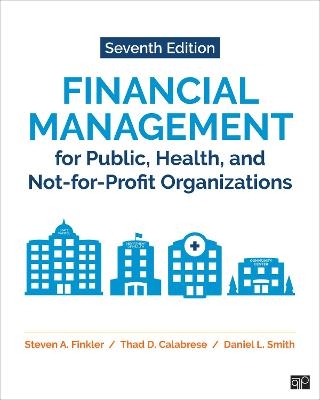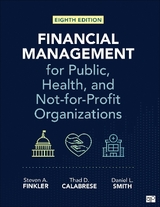
Financial Management for Public, Health, and Not-for-Profit Organizations
Cq Press (Verlag)
978-1-0718-3533-3 (ISBN)
- Titel erscheint in neuer Auflage
- Artikel merken
Dr. Steven A. Finkler is Professor Emeritus of Public and Health Administration, Accounting, and Financial Management at New York University’s Robert F. Wagner Graduate School of Public Service (NYU Wagner). At NYU Wagner he headed the specialization in health services financial management for more than 20 years. Dr. Finkler is an award-winning teacher, author, and researcher.Among his publications are 33 books, including Accounting Fundamentals for Health Care Management, 4th ed. (with Thad Calabrese and David Ward, 2024); and Finance and Accounting for Nonfinancial Managers, 6th ed. (forthcoming, 2024), and Financial Management for Nurse Managers and Executives, 5th ed. (with Cheryl Jones and Christine T. Kovner, 2019). He has also published more than 200 articles in many journals, including Health Services Research, Journal of Public Policy and Management, and Healthcare Financial Management. He received a bachelor of science degree in economics (summa cum laude with dual majors in accounting and finance), and a master of science degree in accounting (with High Honors) from the Wharton School at the University of Pennsylvania, and a master of science degree in economics and doctorate in business administration at Stanford University. Dr. Finkler, who is also a certified public accountant, worked as an auditor with EY (Ernst and Young Global Ltd.) and was on the faculty of the Wharton School before joining NYU. He is a past member of the executive board of the International Society for Research in Healthcare Financial Management and the editorial board of Health Care Management Review, and he served as treasurer and a member of the board of governors of the Daughters of Israel Geriatric Center. He was the editor of Hospital Cost Management & Accounting for 12 years and is a past member of the National Advisory Council for Nursing Research at the National Institutes of Health. He consults extensively, both around the country and abroad. Thad D. Calabrese, PhD, is Professor of public and nonprofit financial management at NYU Wagner, and is director of the school’s finance specialization. His research focuses on not-for-profit and government accounting and finance and is published in the Journal of Public Administration Research and Theory, Public Administration Review, Public Budgeting & Finance, Journal of Accounting and Public Policy, Nonprofit and Voluntary Sector Quarterly, National Tax Journal, Public Finance Review, and Nonprofit Management & Leadership (NML), among others. In addition, he has served in several member-elected positions, including Chair of the Association for Budgeting and Financial Management and Treasurer for the Association for Research on Nonprofit Organizations and Voluntary Action. He also served on the Governmental Accounting Standards Advisory Council for six years until 2023. Prior to entering academia, he worked as a financial manager in the not-for-profit sector and in local government. Daniel L. Smith, PhD, is Associate Dean for the Social Sciences in the College of Arts & Sciences and Professor in the Biden School at the University of Delaware. His research focuses on state government budgeting and financial management and appears in Journal of Policy Analysis and Management, Journal of Public Administration Research and Theory (JPART), Public Administration Review (PAR), Public Budgeting & Finance, and Public Choice, among others. In addition, he has been coeditor of JPART and has served on PAR’s editorial board. Dr. Smith is a past chair of the Association for Budgeting and Financial Management and a former member of the Governmental Accounting Standards Advisory Council. He is also a former member of the Commission on Peer Review and Accreditation (COPRA). He earned his doctorate in public administration in the School of Public and International Affairs at the University of Georgia.
Preface
Case Examples
About the Authors
Part I: Introduction: Setting the Stage
Chapter 1: Introduction to Financial Management
What Is Financial Management?
Public Sector Resource Flows
Why Discuss Public, Health Care, and Not-for-Profit in One Book?
Why Should Public Service Organizations Worry About Financial Management?
Should Public Service Organizations Earn a Profit?
Ongoing Case Study
Summary
Key Terms from This Chapter
Questions for Discussion
Appendix 1-A. Fundraising
Key Terms from This Appendix
Part II: Planning
Chapter 2: Planning for Success: Budgeting
Mission
Strategic Plan
Long-Range Plan
Budgets
Behavioral Aspects of the Budget Process
Summary
Key Terms from This Chapter
Questions for Discussion
Problems
Chapter 3: Additional Budgeting Concepts
Line-Item and Responsibility Center Budgets
Centralization versus Decentralization
Program and Functional Budgets
Budgeting Techniques
Additional Governmental Budgeting Issues
Summary
Key Terms from This Chapter
Questions for Discussion
Problems
Appendix 3-A. A Performance Budget Example
Appendix 3-B. Forecasting Using Historical Data
Key Terms from This Appendix
Chapter 4: Understanding Costs
Basic Concepts and Definitions
Cost Behavior
Break-Even Analysis
Cost Measurement
Summary
Key Terms from This Chapter
Questions for Discussion
Multiple Choice and Fill in the Blank Questions
Problems
Appendix 4-A. Additional Break-Even Analysis Issues
Appendix 4-B. Using Excel to Solve Break-Even Problems
Chapter 5: Capital Budgeting
Why Do We Need a Separate Capital Budget?
Definition of Capital Assets: Theory and Practice
Why Do Capital Assets Warrant Special Attention?
The Time Value of Money
Capital Asset Investment Analysis
Summary
Key Terms from This Chapter
Questions for Discussion
Exercises (TVM)
Problems
Appendix 5-A. Using Computer Spreadsheets for Time Value of Money Calculations: Examples
Appendix 5-B. Using a Financial Calculator for Time Value of Money Calculations
Chapter 6: Long-Term Financing
Equity Financing
Long-Term Debt
Social Impact Bonds
Summary
Key Terms from This Chapter
Questions for Discussion
Exercises (TVM)
Problems
Part III: Implementation and Controlling Results
Chapter 7: Managing Short-Term Resources and Obligations
Working Capital Management
Short-Term Resources
Short-Term Obligations
Summary
Key Terms from This Chapter
Questions for Discussion
Problems
Appendix 7-A. Economic Order Quantity
Key Term from This Appendix
Appendix 7-B. Credit Terms
Chapter 8: Accountability and Control
Management Control Systems
Measures of Performance
Controlling Quality
Variance Analysis
Ethics
Safeguarding Resources
The Form 990
Consequences of Ethical Violations
Summary
Key Term from This Chapter
Questions for Discussion
Problems
Part IV: Reporting Results
Chapter 9: Taking Stock of Where You Are: The Balance Sheet
The Framework for Financial Accounting
Generally Accepted Accounting Principles
International Financial Reporting Standards
Fiscal Years
Balance Sheet Elements
Assets: A Closer Look
Liabilities: A Closer Look
Net Assets or Fund Balance: A Closer Look
Recording Financial Information
Summary
Key Terms from This Chapter
Questions for Discussion
Problems
Appendix 9-A. The Recording Process: Debits and Credits
Appendix 9-B. Using Dollar Signs and Underlines in Accounting
Chapter 10: Reporting the Results of Operations: The Activity and Cash Flow Statements
The Activity Statement
The Statement of Cash Flows
Interrelationships among Financial Statements
Notes to Financial Statements
Recording and Reporting Financial Information
Starting from Scratch
Summary
Key Terms from This Chapter
Questions for Discussion
Problems
Appendix 10-A. Sources of Revenue for Governments
Key Terms from This Appendix
Appendix 10-B. Accelerated Depreciation Methods
Appendix 10-C. Inventory Valuation Methods
Appendix 10-D. The Recording Process: Debits and Credits
Appendix 10-E. The Accounting Cycle
Chapter 11: Unique Aspects of Accounting for Not-for-Profit and Health-Care Organizations
Accounting for Not-for-Profit Organizations
Fund Accounting
Depreciation
Donated Goods and Services
Investments
Taxes
Accounting for Health-Care Organizations
Summary
Key Terms from This Chapter
Questions for Discussion
Problems
Appendix 11-A. Taxation of Not-for-Profit Entities
Chapter 12: Unique Aspects of Accounting for State and Local Governments—Part I: The Recording Process
Bases of Accounting
Government Fund Accounting
Recording Financial Information
Summary
Key Terms from This Chapter
Questions for Discussion
Problems
Appendix 12-A. The Recording Process: Debits and Credits
Chapter 13: Unique Aspects of Accounting for State and Local Governments—Part II: Reporting Financial Results
Reporting Financial Information
Summary
Key Terms from This Chapter
Questions for Discussion
Problem
Appendix 13-A. Interrelationships among Government Financial Statements
Part V: Financial Analysis
Chapter 14: Financial Statement Analysis
Financial Statement Review
The Notes That Accompany Financial Statements
Ratio Analysis
Assessment
Summary
Key Terms from This Chapter
Questions for Discussion
Problems
Chapter 15: Financial Condition Analysis
Financial Condition Analysis
Financial Statement Analysis versus Financial Condition Analysis
Ratio Analysis
Summary
Key Terms from This Chapter
Questions for Discussion
Problems
Appendix 15-A. Bond Ratings
Key Terms from This Appendix
Glossary
Index
| Erscheinungsdatum | 09.03.2022 |
|---|---|
| Verlagsort | Washington |
| Sprache | englisch |
| Maße | 203 x 254 mm |
| Gewicht | 1760 g |
| Themenwelt | Sozialwissenschaften ► Politik / Verwaltung ► Staat / Verwaltung |
| Wirtschaft ► Betriebswirtschaft / Management ► Finanzierung | |
| Wirtschaft ► Betriebswirtschaft / Management ► Planung / Organisation | |
| ISBN-10 | 1-0718-3533-5 / 1071835335 |
| ISBN-13 | 978-1-0718-3533-3 / 9781071835333 |
| Zustand | Neuware |
| Haben Sie eine Frage zum Produkt? |
aus dem Bereich



